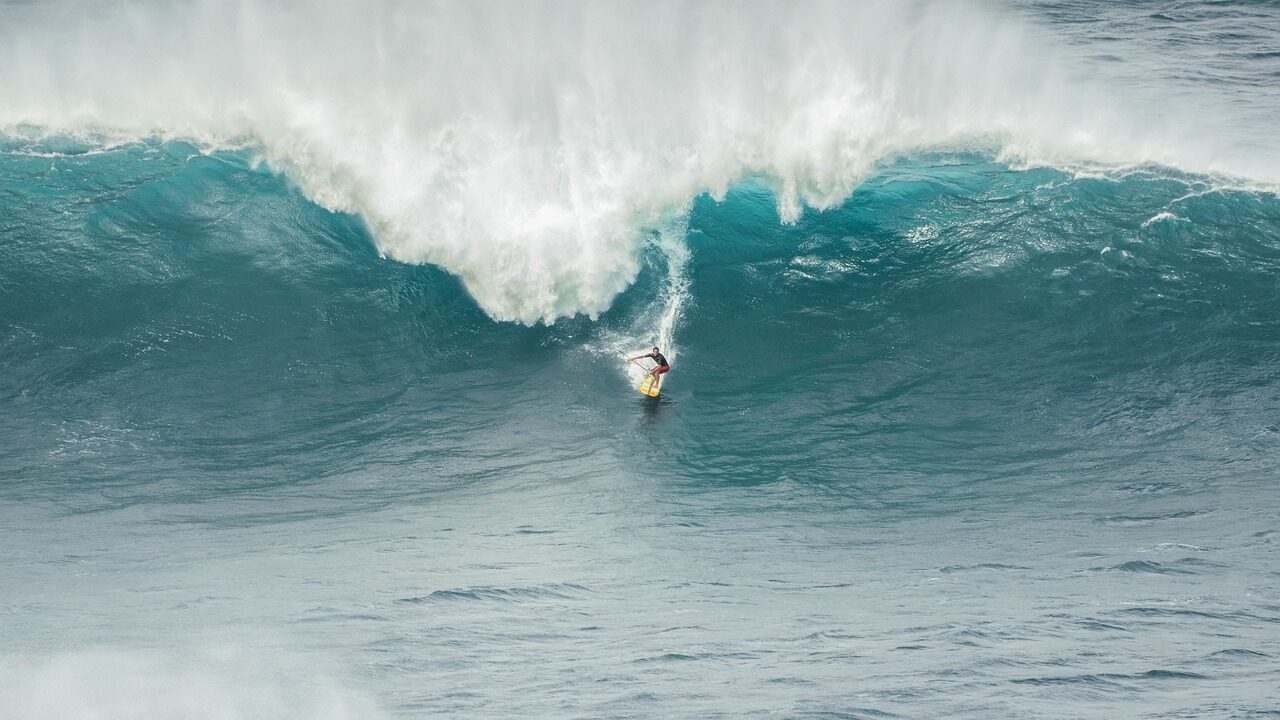
Table of Contents
Ever watched in awe as surfers glide effortlessly across the ocean’s surface, seemingly defying gravity as they harness the power of the waves? Surfing isn’t just a sport—it’s a thrilling dance with nature that captivates adventurers and water enthusiasts alike. And at the heart of this exhilarating pursuit lies the quest for speed.
In this exploration, we delve into the fascinating world of surfing velocity, uncovering the factors that propel surfers to incredible speeds and the techniques they employ to ride the waves with finesse. From the gentle swells of beginner-friendly breaks to the towering giants of big wave surfing, join us as we ride the currents of curiosity and discover just how fast surfers go.
I. How Fast Do Surfers Go?
Surfing isn’t just about catching waves; it’s about embracing the rush of speed as you glide along the water’s surface. But just how fast do surfers zip across those waves? Let’s dive into the numbers.
Surfers can reach speeds ranging from an average of 5 to 30 miles per hour, depending on various factors such as wave size, shape, wind conditions, and the skill level of the surfer. Imagine cruising down a highway at 30 miles per hour – that’s the upper limit of speed some surfers can achieve on the right wave under ideal conditions.
From beginners mastering the basics to seasoned pros conquering towering waves, the speedometer of a surfer’s ride can vary greatly. And when it comes to professional surfers, prepare to be amazed by the velocity they achieve as they carve through the waves with unmatched skill and finesse.
But it’s not just about raw speed; it’s about the thrill of the ride, the connection with the elements, and the sheer joy of surfing. So, buckle up (or rather, wax up your board), as we explore the exhilarating speeds of surfers and the magic that happens when humans meet the sea.

II. how fast does a surfer go on a big wave?
While the speeds of surfers on regular waves can be impressive, the velocity achieved on big waves takes the concept of surfing speed to a whole new level. When it comes to conquering colossal swells, surfers push the boundaries of what’s humanly possible.
On big waves, surfers can reach astonishing speeds, often exceeding 30 miles per hour and sometimes even surpassing 40 miles per hour. These monstrous waves, propelled by immense energy, provide the platform for surfers to showcase their skill, courage, and raw athleticism.
The velocity attained on big waves is not just a result of the surfer’s prowess but also a testament to the sheer power of nature. Riding these giants requires impeccable timing, unwavering focus, and a deep understanding of wave dynamics.
Professional big wave surfers, in particular, demonstrate unparalleled bravery and expertise as they navigate towering walls of water with awe-inspiring speed. From the legendary breaks of Mavericks to the infamous barrels of Teahupo’o, these athletes harness the immense energy of the ocean to achieve speeds that border on the unbelievable.
However, with great speed comes great risk. Surfing big waves is not for the faint of heart, and the consequences of a fall can be severe. Despite the allure of speed and adrenaline, safety always remains paramount in the world of big wave surfing.
III. Factors Influencing Surfing Speed
Ever wondered what makes surfers zoom across waves with such varying speeds? Let’s uncover the key factors.
Wave Characteristics
- Size Matters: Larger waves provide more energy for surfers to harness, propelling them at higher speeds.
- Shape and Momentum: The curvature and movement of a wave influence how smoothly a surfer can ride it, affecting their speed.
Environmental Conditions
- Wind Speed and Direction: Tailwinds can boost a surfer’s speed, while headwinds may create resistance, slowing them down.
- Currents and Tides: The flow of water beneath the surface can either assist or impede a surfer’s progress.
Surfer’s Skill Level
- Technique Is Key: Experienced surfers possess the ability to read waves effectively and execute maneuvers that maximize speed.
- Confidence and Control: A surfer’s comfort level on the board contributes to their agility and speed on the waves.
Understanding these factors sheds light on the dynamic interplay between surfers and their aquatic playground. As we unravel the secrets of surfing speed, we gain a deeper appreciation for the harmony between humans and the ever-changing sea.
IV. Techniques to Boost Surfing Speed
Surfing isn’t just about catching waves; it’s about mastering the art of harnessing momentum. Let’s uncover some key techniques surfers use to ride the waves with speed and finesse.
Pumping
- Like a seasoned cyclist navigating hills, surfers use pumping motions to generate speed by shifting their weight and rhythmically compressing and extending their legs.
Trimming
- Picture a sailboat adjusting its sails to catch the wind just right. Surfers trim their body and board positions to optimize their speed and glide effortlessly across the water.
Reading the Waves
- Surfers aren’t just passive riders; they’re active participants in the dance of the waves. By keenly observing wave patterns and anticipating their movements, surfers can position themselves for maximum speed and performance.
By mastering these techniques, surfers unlock the full potential of their rides, propelling themselves across the waves with grace and precision. As we delve deeper into the nuances of surfing speed, we discover the subtle yet powerful ways in which surfers interact with their aquatic environment.
V. Equipment’s Role in Speed Optimization
Surfers rely on more than just their skills; their equipment plays a crucial role in enhancing speed and performance. Let’s explore how surfboard design and gear advancements contribute to maximizing surfing speed.
Surfboard Design
- From sleek outlines to hydrodynamic contours, modern surfboard designs are crafted to minimize drag and increase speed.
- Tail Shapes: Different tail shapes, such as swallowtails or pintails, offer varying degrees of control and speed in different wave conditions.
Fin Technology
- Fins aren’t just for stability; they’re also instrumental in propulsion. Advanced fin designs, including asymmetric and adjustable fins, optimize control and speed.
- Fin Configurations: Experimenting with various fin setups allows surfers to fine-tune their board’s performance for different wave types and riding styles.
Gear
- Wetsuits and Rash Guards: Streamlined wetsuit designs reduce drag, allowing surfers to move more efficiently through the water.
- Safety Equipment: Helmets and impact vests not only protect surfers from injuries but also minimize resistance, enabling smoother rides and increased speed.
By staying abreast of the latest equipment innovations and selecting gear tailored to their needs, surfers can elevate their performance and push the boundaries of speed on the waves. As we delve into the realm of surfing equipment, we uncover the symbiotic relationship between technology and tradition, enhancing the surfing experience for enthusiasts worldwide.
VI. Safety Precautions at High Surfing Speeds
Surfing is undeniably thrilling, but it’s essential to prioritize safety, especially when riding at high speeds. Let’s explore the safety considerations surfers must keep in mind to enjoy their rides responsibly.
Acknowledging Risks
- Wipeouts: Even the most skilled surfers can take a tumble. It’s crucial to be prepared for wipeouts and understand how to navigate them safely.
- Collisions: With crowded lineups and fast-moving waves, collisions with other surfers or stationary objects can occur. Maintaining awareness of one’s surroundings is key to avoiding accidents.
Training
- Building Skills: Proper training and practice help surfers develop the skills necessary to navigate waves confidently and safely.
- Water Safety: Understanding ocean currents, rip currents, and other potential hazards equips surfers with the knowledge to make informed decisions and mitigate risks.
Situational Awareness
- Stay Alert: Surfing requires constant vigilance. Surfers must remain attentive to changes in wave conditions, incoming sets, and the presence of other surfers.
- Respect Others: Being considerate of fellow surfers and adhering to surfing etiquette helps maintain a safe and enjoyable environment for everyone in the lineup.
By prioritizing safety and adopting responsible surfing practices, surfers can minimize risks and enjoy their time in the water to the fullest. As we navigate the exhilarating world of surfing, let’s remember to ride with caution and respect for ourselves, others, and the ocean.

VII. Conclusion
In the captivating realm of surfing, speed is more than just a measurement—it’s a thrilling journey that intertwines human skill with the power of nature. From the average speeds of 5 to 30 miles per hour on regular waves to the breathtaking velocities exceeding 40 miles per hour on monumental swells, surfers continually push the limits of what’s possible.
As we’ve explored the factors influencing surfing speed, delved into techniques for optimizing velocity, and examined the role of equipment in enhancing performance, one thing remains clear: surfing is a dynamic fusion of athleticism, technique, and sheer exhilaration.
Whether riders are racing down the face of a towering wave or gracefully gliding across a tranquil swell, the joy of surfing lies not just in the raw speed, but in the profound connection with the ocean’s rhythmic pulse. It’s a sport where every wave is an invitation to dance with the elements, and every ride is a testament to the harmony between human ingenuity and the boundless energy of the sea.
So, next time you wax up your board and paddle out, remember the magic of surfing lies not only in how fast you go, but in the unforgettable moments of pure freedom and joy that come with every wave you catch. Embrace the rush, savor the journey, and let the waves carry you into the timeless embrace of the ocean.
